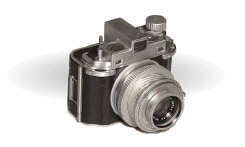 |
|||||
|
The Kodak Medalist was an unusual design for a medium format camera when it was introduced in 1941. Most rollfilm cameras of this vintage were folders, similar to the Kodak Tourist shown in this site. The Medalist, however, was a rigid cast-aluminum body design with a unique double helical lens tube in place of the conventional cloth bellows. This design was stronger, protected internal mechanisms better and was nearly as compact when the lens was retracted. The Medalist was used extensively during WWII by the American services. Like other Kodaks designed to use 2.5 inch roll film, it was spooled on 620 spools, which had the same film width as 120, but with a smaller spool core and thinner flanges. Film is advanced with a conventional knob, and while there is a red window on the camera back to view the numbers on the backing paper, this is only necessary to index the first frame; then a small knob on the camera's top is set to start the auto frame measuring feature. Winding the film cocks the shutter. Intentional double exposures can be made by cocking the shutter manually again with a lever to the right of the finder window. The Medalist
has an unusually bright finder Lacking interchangeable lenses, the Medalist could not be considered a true system camera, but medium format rangefinder cameras with interchangeable lenses were at best rare in 1941. The Medalist was offered with a fair number of accessories. The most unusual feature--the back design--allowed use of rollfilm, sheet film packs and cut sheet holders. The back can be opened from either side or removed completely. An auxiliary ground glass back can be fitted to allow critical focusing and, when this is in place, 6x9 film packs or 6x9 sheet film holders can be used. While this arrangement did not have the flexibility of the Ektra for film interchangability, it did allow for direct focusing when doing closeup work. The Kodak Precision and Flurolite enlargers were designed so that their enlarging heads were removable, presenting a platform and accessories that could be used with the Medalist and other highend Kodak cameras for copy work. We may be inclined to discount such features now, but before thermal and xerographic copying was made readily available in the early 60s, microfilming was an important way of preserving personal and business documents. The lens on
the Medalist is a 5-element coated f/3.5 Ektar
Because the
design of the 100mm Ektar on the Medalist was so successful and because
so many of these were produced, it is not uncommon to find the occassional
unmounted Medalist lens/shutter at auction or camera shows. Before you
get carried away, as I did, with visions of this lens mounted on your
Graphic 23 or a view camera, consider that it is not a typical lens/shutter
design for this period. In the linked window |
|||||
| The Medalist is often described as a large, heavy camera. For storage, the double helical tube retreats into the body, for a total depth of 3.75 inches; fully extended it is 5 inches deep. The comparison below is perhaps a bit unfair, since the Nikon has BTL metering, but by 1965 standards could the Medalist be considered large and heavy? Considering that the Medalist produced a 6x9cm negative, it was compact when compared to 2x3 press cameras, though a different shape is not really larger than 6x9 folders, like the Monitor or Tourist. | |||||
| ##Medalist II |
5.5w
x 4.4h x 4.8d @ Inf |
image area 5400 sq mm | ||
| ##Nikon
F Photomic ##w/1.4 Nikkor |
5.75w
x 4.0h x 4.25d @ Inf 2 lbs, 14 ounces |
image area 864 sq mm |
 04/28/2011 0:49 |
 |
||||